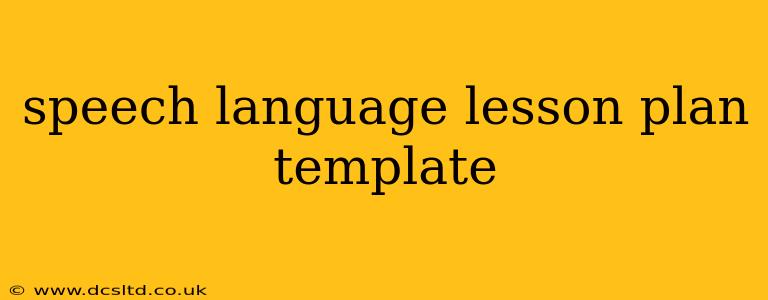This template provides a structured approach to crafting effective speech-language therapy lesson plans. It's designed to be adaptable for various age groups and skill levels, focusing on clarity, measurability, and student engagement.
I. Student Information:
- Name:
- Age:
- Date:
- Diagnosis/Impairment: (e.g., Articulation disorder, Fluency disorder, Language disorder, Apraxia)
- Specific Goals/Objectives (from IEP/IFSP): List the specific, measurable, achievable, relevant, and time-bound (SMART) goals the lesson addresses.
II. Lesson Topic/Theme: (e.g., Verb Conjugation, Describing Objects, Narrative Retelling, Articulation of /s/ blends)
III. Learning Objectives: (What will the student be able to do by the end of the lesson?) These should be measurable and directly linked to the student's goals. Use action verbs (e.g., identify, label, describe, produce, repeat). Example:
- The student will accurately produce the /s/ blend in 8 out of 10 trials.
- The student will correctly identify 5 out of 5 verbs in a sentence.
- The student will retell a simple story with a beginning, middle, and end, including key details.
IV. Materials: (List all materials needed for the lesson. Be specific!) Example:
- Picture cards
- Toys
- Articulation cards
- Storybook
- Whiteboard/marker
- Visual schedule
- Timer
V. Procedures: (Outline the step-by-step activities of the lesson. Include estimated times for each activity.) Be detailed and specific. Consider incorporating various techniques like:
- Warm-up activities: (e.g., tongue exercises, singing, reading) (5 minutes)
- Direct Instruction: (Explicit teaching of the target skill) (15 minutes)
- Modeling: (Demonstrating the correct skill) (5 minutes)
- Practice Activities: (Opportunities for the student to practice the skill, varying levels of difficulty) (20 minutes)
- Reinforcement/Feedback: (Positive reinforcement and specific feedback on performance) (5 minutes)
- Carryover activities: (Activities to practice the skill in different contexts) (5 minutes)
- Cool-down activities: (e.g., a relaxing activity to end the session) (5 minutes)
VI. Data Collection: (How will you track the student's progress?) Example:
- Data sheet with tally marks for correct/incorrect responses.
- Checklist of target behaviors.
- Audio/video recording of sessions.
VII. Differentiation: (How will you adapt the lesson to meet the individual needs of the student? Consider varying the complexity, length, and type of activities.) Examples:
- Provide more support/scaffolding for struggling students.
- Offer more challenging activities for advanced students.
- Use visual supports or cues as needed.
VIII. Assessment: (How will you assess the student's learning at the end of the lesson? This should directly relate to the learning objectives.) Example:
- Administer a brief probe of the target skill.
- Observe the student's performance during practice activities.
- Review data collected throughout the session.
IX. Reflection: (After the session, reflect on what worked well, what could be improved, and how you will adjust the lesson plan for future sessions.) This section is crucial for ongoing improvement.
Example Section: Procedures (Illustrative)
- Warm-up (5 minutes): Begin with tongue stretches and a simple song focusing on articulation of /s/.
- Direct Instruction (15 minutes): Introduce the /s/ blends (/st/, /sk/, /sp/). Model the correct pronunciation, emphasizing lip and tongue placement. Use visual aids (e.g., pictures of a star, a skate, a spoon).
- Practice Activities (20 minutes):
- Activity 1 (10 minutes): Picture card identification: Students name pictures containing /s/ blends.
- Activity 2 (10 minutes): Sentence completion: Students complete sentences with words containing /s/ blends (e.g., "The _______ is shining brightly.").
- Reinforcement/Feedback (5 minutes): Provide positive reinforcement and specific feedback on correct and incorrect productions. Use immediate correction techniques for errors.
- Carryover Activity (5 minutes): Students practice /s/ blends in a short conversation about their favorite things.
This template is a framework. Adjust it to meet the specific needs of each student and the goals of your therapy sessions. Remember that regular review and modification are key to creating effective and engaging lesson plans.
